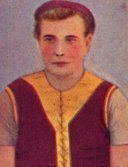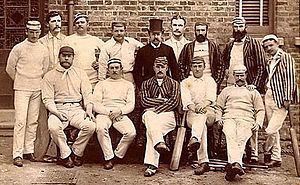Full name John Worrall Name Jack Worrall Original team(s) South Ballarat | ||
 | ||
Date of birth (1861-06-21)21 June 1861 Date of death 17 November 1937(1937-11-17) (aged 76) Role Australian Rules Footballer | ||
Jack worrall pursuit of happiness kid cudi cover project x block c live sessions ep 9
John "Jack" Worrall (20 June 1861 – 17 November 1937) was an Australian rules footballer who played for the Fitzroy Football Club in the VFA, and a Test cricketer. He was also a prominent coach in both sports and a journalist.
Contents
- Jack worrall pursuit of happiness kid cudi cover project x block c live sessions ep 9
- Jack worrall for the boks rwc2015 campaign
- Early life
- Champion Footballer and Test Match Success
- The First Coach
- Journalism and other achievements
- Controversies
- References

A small, nuggety man with broad shoulders, pink complexion and intense brown eyes, Worrall was one of Australia's great all-round sports people of the nineteenth century, and was involved in Australian football and cricket at the elite level for many decades. After his retirement, he coached both sports, and is considered the "father" of Australian football coaching. Worrall had an extended career as a sporting journalist, and he was a highly respected member of the press box right up until his death in 1937. He was no stranger to conflict, and his forthright manner embroiled him in a number of sporting controversies throughout his lifetime.
Jack worrall for the boks rwc2015 campaign
Early life
Born on the Victorian Goldfields at Chinaman's Flat (now in the locality of Snake Valley near Maryborough, Worrall was the seventh child of Irish-born parents, Joseph and Ann. He attended state school in Maryborough, but moved to Ballarat in his early twenties. There, he came under notice playing cricket against the touring English team, which led to his selection for Victoria in 1883. Joining the South Ballarat Football Club, Worrall showed excellent potential and he was persuaded to move to Melbourne and play for the fledging Fitzroy club in 1884. At this stage, Fitzroy had just secured admission to the game's elite competition, the Victorian Football Association (VFA). Worrall became a major factor in the emergence of Fitzroy as a powerful team. During summer, he turned out for the Fitzroy Cricket Club.
On Saturday, 27 September 1884, Worrall was playing a cricket match at Albert Park. The Fitzroy Football Club, short of a man, prevailed upon Worrall to play in their team in the match against South Melbourne in Fitzroy's last match for 1884 (Worrall's first season with that club) . Worrall played the entire match for Fitzroy, in his "white flannels"!
The move to Fitzroy dramatically improved Worrall's prospects in both sports. He played his first Ashes test match in the 1884–1885 season, when he was called into the team at the last minute to replace a player who was in financial dispute over his proposed fee for the game. At this time in his career, Worrall was a middle-order bat who bowled medium pace. He failed to secure a regular place in the test team, and was not always a regular selection for the Victorian team.
Champion Footballer and Test Match Success
Worrall's football showed more consistency than his cricket. Already captain of the team, Worrall played as a rover. He was skilled, fearless, could kick with either foot and was an excellent overhead mark for his size. Regularly selected for the Victorian team, he is one of very few men to have represented Victoria at both sports. Football was put on hold the following winter when he was chosen to tour England with the Australian cricket team.
Along with most of his teammates, Worrall struggled during the wet English summer and failed to enhance his reputation. On his return to Melbourne, he was named The Argus Player of the Year in 1890, and Fitzroy's key player during these years. Injury got the better of him in 1892, and he retired from football, which allowed him to concentrate on the summer game. The next year, he married Agnes McCullum in Fitzroy.
He switched allegiance to the Carlton Cricket Club and in 1896 scored an Australian- record 417 not out for the Blues in a match with University. He reorganised his style, becoming a more aggressive batsman who often opened but no longer bowled. In addition, he was inspirational in the field and his leadership qualities were recognised with the Victorian captaincy sixteen times. A number of big innings for the state kept him in contention for higher honours. This late blooming of his talent culminated in selection for the 1899 tour of England, during which he turned 38. Partnering the legendary Victor Trumper at the top of the order for all five tests, Worrall had his greatest day in the Headingley test match when he scored 76 on a sticky wicket to set up an Australian victory. However, his advanced age meant that this was his last test series, although he continued with Victoria until 1902, when he was 40. In 140 first class matches, he scored 4660 runs at 20.99, took 105 wickets at 23.10, held 101 catches and scored seven centuries.
The First Coach
Carlton had been one of the power clubs of the early decades of Australian football, but fell into a state of decline during the 1890s that lasted through to the early years of competition in the VFL (which began in 1897). In 1902, Worrall, secretary of the Carlton Cricket Club, was appointed to the same role with the football club. Hitherto, Australian footballers were prepared in an ad hoc way commensurate with the organisation of the game as a semi-professional sport where official payments were outlawed, but made surreptitiously. Worrall immediately set about leading training sessions, instructing players, formulating tactics and recruiting talent in a manner that created the role of club coach that is recognised today. For a number of years, he was often referred to as the club's "manager" or "secretary", until the term "coach" passed into common usage. Carlton's rapid improvement encouraged other VFL clubs to appoint a coach, and these men used Worrall as their role model.
The Blues climbed the ladder quickly, making the finals in 1903-04-05 without winning the flag. Worrall's old club Fitzroy were the benchmark of the competition at this point, and eliminated Carlton from the finals in the latter two years. Worrall continually turned over players in an effort to find the right combination for success. Eventually, he developed a big, strong team that favoured long kicking and liked to close up the game, forming packs and using their physical strength in the crushes. Fitness was a priority for Worrall: he ensured that his team trained harder than the opposition. Finally, in 1906, Carlton defeated their nemesis Fitzroy in the Grand Final by a record margin with a young team that seemed to have the footballing world at its feet.
This success was followed up by winning the next two premierships, the first hat-trick success by a club in the VFL. The 1908 performance was the highlight of Worrall's coaching career. The Blues lost only one game (by five points on a very muddy ground against Essendon) for the year, a record equalled but never betean subsequently in VFL/AFL history.
Inevitable tensions arose, however, as the players were receiving only a 30 shillings ($3) per week, yet were training to a professional standard. Adding to the players' dissatisfaction was the increased money coming into the game – Carlton's revenue had doubled since the time of Worrall's appointment. Worrall's sometimes brusque approach to dealing with individuals and his puritanical attitude to alcohol and other distractions didn't help the situation. Early in 1909, Carlton's players revolted over money and Worrall's disciplinary demands, and some refused to take the field in the opening round. The matter rumbled on for a number of weeks, with a small group of players insisting on Worrall's resignation, which was duly given mid-season. He continued on as secretary, but resigned that position at the end of the season when the disharmony was still not repaired. A number of players who supported the ex-coach left Princes Park in sympathy.
After a season spent employed by the VFL as the umpires' coach, Worrall was recruited by Essendon. Here, he took a talented but previously under-performing team to a premiership in his first season. The next year, 1912, an injury-ravaged Essendon team somehow managed to upset hot favourites South Melbourne in the Grand Final. Over five completed seasons, Worrall had now coached five premiership teams. But the team declined rapidly thereafter and went into recess in 1916–1917, due to World War I. Performances failed to improve when the Same Old returned to competition, winning only fifteen out of 46 games between 1918 and 1920, prompting Worrall's retirement. The team finished last in 1918, and Worrall became the first man to coach both a premiership and a wooden-spoon team. In 1922, he reappeared briefly as an assistant to Vic Belcher at his old team Fitzroy, which went on to win the premiership from Collingwood.
Journalism and other achievements
Worrall was a driving force behind the creation of the Australian Football Council (AFC) in 1905. Formed as the peak body of Australian football, the organisation initially took control of the rules of the game and organised the first interstate carnival between the Australian states and New Zealand in 1908. Worrall was elected as one of the Victorian delegates. In 1909, the Victorian Cricket Association (VCA) made Worrall coach of the state's colts team, which played at district level and was designed to develop young talent.
Beginning his journalism career with the Sydney Referee after his retirement from playing cricket, Worrall expanded his involvement in the press during Essendon's hiatus from the VFL in 1916. He joined the Australasian, and wrote on both sports. John Ritchie, in the Australian Dictionary of Biography, described his writing thus:
For over twenty years his columns were characterized by poised sentences and rich vocabulary; for all its partisanship, his direct prose was spiced with comparison, reminiscence and prediction, and conveyed a sense of drama.
In the 1930s, he was the senior man in the press box, and many attribute the coining of the phrase "bodyline" (describing the English bowling tactics on their 1932–1933 Australian tour) to Worrall. He died in the Melbourne suburb of Fairfield, early in the 1937–1938 cricket season, survived by his wife; the couple had one child, a daughter, Doris Lilian. The flags at the MCG, the scene of so many of his sporting triumphs, flew at half mast during a Sheffield shield match in honour of Worrall. His funeral at Heidelberg attracted a massive crowd of former footballers, cricketers, journalists and administrators.
In 1996 Worrall's outstanding contributions to the game of Australian rules football were recognised when he was inducted into the Australian Football Hall of Fame as a player.
